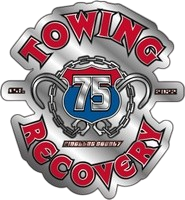Flatbed towing involves loading an entire vehicle onto a truck’s flat, hydraulic bed, while flat towing (or “dinghy towing”) is a specific method of towing a vehicle by attaching it to a recreational vehicle (RV) via a tow bar, allowing all four wheels to remain on the ground
Selecting an incorrect towing procedure may damage your vehicle or incur additional costs. This guide simplifies all that you need to know concerning the two options. We will inform you about the main differences, pros, and cons related to each of the two methods to help you make a wise choice.
What is Flat Towing?
Flat towing (sometimes called four-down towing or dinghy towing) is a method when a vehicle is being towed with all its four wheels on the ground. The towed car is right behind the towing car; the two vehicles are linked using the tow bar or a tow dolly. The practice is typical among those RV owners who come to their destination to bring a smaller vehicle to make local journeys.
Special equipment must be installed, such as a tow bar and safety chains, and both the vehicle being towed and sometimes the braking system must be in place. Flat towing is not for all cars. This towing technique requires that the drive train, transmission, and other parts be compatible to avoid damage.
What is Flatbed Towing?
Flatbed towing employs a special truck with a horizontal flat bed or hydraulic bed, which is lowered to the ground. This bed is completely transported vehicle using the system of winches. After being anchored, the whole vehicle is planned to be hoisted up in the air to be transported.
That is the safest way of protecting the towed vehicle. No wheels come in contact with the road during transportation, removing tire wear and lessening the burden on the drivetrain. Flatbed trucks are available in different dimensions depending on the type of vehicle, such as small or big trucks, and SUVs.

The Real Differences Between Flat Towing and Flatbed Towing
The flat towing is a method to tow a car/vehicle attaching it to the RV by using tow bar while flat bed consist of a special truck having flat or hydraulic bed.
Journey Considerations
Flat towing is most useful when going on long trips where the towed vehicle is a necessity at the endpoint. That is one of the frequently selected approaches by the V enthusiasts to cover cross-country trips. The installation provides greater mobility when travelling in campsites and taking rest stops.
Flatbed towing is ideal for transporting short distances or medium distances, especially in urban areas. The nature of transportation, which is enclosed, is suitable when transportation involves the delivery of valuable or damaged cars. It is also the best way to move on in a major traffic jam or a construction site.
Distance Capabilities
Flat towing does not have distance limitations, provided the equipment has been maintained to handle the unlimited miles. The major drawback is that of driver fatigue and gas use. Long tourist road-trips need to be broken with check stops to ensure that connections are holding and the final vehicle is in good condition.
Flatbed technology is characterized by shorter distances, primarily because of the costs incurred and wear and tear of equipment. The majority of the flatbed operators are regional regarding their operations. The needs of exotic cars, classic automobiles, or even commercial transportation may have special long-distance flatbed services available.
Weight Handling Capacity
The use of flat towing requires the specifications of the towing vehicle and the tow bar rating. Cars that weigh between 3,000 and 5,000 pounds can be accommodated in most consumer setups. There is the capability of heavy-duty equipment to tow heavier vehicles, but at the cost of more powerful towing vehicles being used.
Flatbed trucks are also weight-efficient, with the weight capacity of 10 to 25 thousand or more being common. Several cars can be carried with the help of commercial flatbed trucks at the same time. The flat towing arrangements do not offer better stability than the weight distribution on the flatbed.
Learn More: What Vehicles Can Be Flat Towed: A Complete Guide
Equipment and Setup Requirements
Flat towing is an expensive venture in acquiring equipment. Costs of tow bars, wiring harnesses, braking systems, and safety equipment are thousands of dollars. The installation commonly needs the assistance of a professional so that they can be installed correctly and in a safety-compliant manner.
Flatbed towing removes the need for ownership of equipment because the service provider provides everything. You summon the service when it is required. That is more effective when used on a less frequent basis, or when you find yourself in an emergency circumstance and do not wish to purchase towing gear.
Pros and Cons of Flat Towing
Advantages of Flat Towing
The most significant advantage of flat towing is that it is cost-effective. The cost of buying the equipment is also not high; once you own the equipment, maintenance is the only remaining continuing cost. That renders flat towing cost-effective to regular commuters or automobile transporters.
As an RV owner and a long-distance driver, convenience is a huge factor. When you are in a new place, it is advantageous to have your vehicle because this will give you freedom and flexibility. You will have a chance to get familiar with local areas without the use of rental cars or transportation.
Disadvantages of Flat Towing
There is the most significant restriction on vehicle compatibility in the case of flat towing. Most current vehicles (particularly those with an automatic transmission) cannot be flat towed without a special modification. Other manufacturers may invalidate warranties under the circumstances of inappropriate flat towing.
New users can be scared off by the complexity of setup. Knowledge and care are essential to properly connect electrical systems, safety chains, and braking elements. Errors made in setup may lead to accidents or damage to a vehicle.
Pros and Cons of Flatbed Towing
Advantages of Flatbed Towing
Flatbed towing is characterized as maximum protection. Your vehicle never touches the road, which eliminates tire wear (tires, brakes, drive train parts, etc.). This security is essential in the case of old-time cars, luxury cars, or cars with damage that are not able to move safely.
It is universal, whereby any vehicle can be transported on the flat bed. Regardless of the transmission issues on your vehicle, flat tires, or accident damage, a flatbed service can deal with any of them. This flexibility has made the most preferred option to be used in emergency roadside assistance.
Disadvantages of Flatbed Towing
The significant disadvantage of flatbed services is that they are more expensive. Average towing charges on the professional side vary between 75 and 125 dollars in local areas, and longer routes come at extra costs. Such expenses are also quick to accumulate when they involve several transports or long-distance relocations.
That might be a problem when it is not readily available either in rural regions or when demand is high. Flatbed trucks even take more time to load and offload cars than flat towing. That may end up causing prolonged waits during emergency times or peak periods.
Learn More: Difference Between Flatbed and Regular Tow Trucks
Choosing the Right Towing Method
Consider flat towing, especially when you use the exact vehicle to travel a long way frequently. That is usually the best approach when used by RV owners, frequent travellers, and seasonal residents. Initial equipment investment is repaid using minimized long-term costs.
Use flatbed towing when your vehicle is valuable, in case of emergency, or when you require a professional service. This method is preferred by the owners of classic cars and luxury vehicles, as well as by all people faced with the problems of vehicle breakdowns. The protection and convenience provided are well worth the extra cost.
Making Your Towing Decision
Flat towing and flatbed towing are valuable in the towing of any vehicle. Your decision will lie in such aspects as frequency of use, the type of vehicles, distance needs, and budget questions. Knowing these differences will be valuable to keep in mind as you specify the most suitable approach in your particular case.
Make this choice based on your long-term transportation requirements. Those who travel regularly may invest in the means of flat towing, whereas those who rarely travel should resort to professional services that offer flat towing. In any case, adequate planning guarantees safe and effective shipping of the vehicle.
